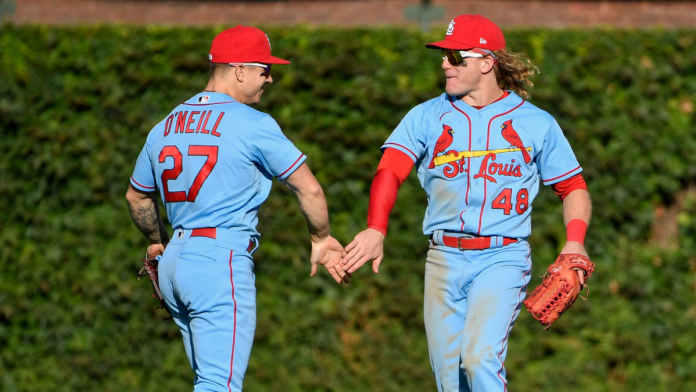
On Aug. 8 following a 6-5 home loss to the otherwise humble Royals, the St. Louis Cardinals fell one game below .500. With less than two months of regular season remaining, their playoff odds were, according to most sources for such things, less than 3.0 percent. Throw in the somewhat baffling deadline additions of dubious veteran starters Jon Lester and J.A. Happ, and the Cardinals seemed bound to see their mini-streak of two straight playoff appearances come to an end.
Things, though, changed and did so to extreme degrees. After slipping below the waterline on Aug. 8, Mike Shildt’s club immediately won six in a row and then struggled across a 10-13 stretch. That, however, led into the ongoing 16-game winning streak that redefined the 2021 season in St. Louis. Thanks to the streak — and struggles elsewhere in the NL playoff race — the Cardinals have seized their fellow contenders for the final NL wild card spot by the lapels and thrown them from a moving train. St. Louis has now secured its 14th straight winning season and will almost certainly lock up a playoff bid in the days to come (the club’s magic number is one entering the week).
So what’s happened? How does what was a rather ordinary looking team on the fringes of relevance conjure up the longest winning streak in franchise history? As you might have guessed, it’s not any one thing…
1. The offense has been crushing the ball
Not surprisingly, the Cardinals have unlocked big power over the last 16 games. Prior to the winning streak, the St. Louis offense ranked 23rd in MLB with a slugging percentage of .396, and they ranked 24th in home runs. During the streak, the Cardinals lead all of baseball with a slugging percentage of .531 (33 points ahead of the No. 2 team, the Blue Jays). They’re also tied for the MLB lead over the last 16 games with 31 home runs. To put that slugging percentage in context, Aaron Judge of the Yankees at this writing also has an SLG of .531. So since Sept. 11 the Cardinals have been hitting for power like a lineup full of Aaron Judges. Optimal, that.
Please check the opt-in box to acknowledge that you would like to subscribe.
Thanks for signing up!
Keep an eye on your inbox.
Sorry!
There was an error processing your subscription.
Paul Goldschmidt and Tyler O’Neill have been particularly deadly during the win streak. Goldbird came into Sunday’s series finale in Wrigley with a slash line of .386/.463/.825 over the prior 15 games, and then he went out and homered for seventh time during the streak. O’Neill coming into Sunday’s tilt had a slash line of .305/.354/.695 for the streak with, like Goldschmidt, seven home runs. In that 16th straight win on Sunday, O’Neill added a pair of singles to his pile.
As a partial consequence of their recent run, the Cardinals now boast three 30-homer hitters (Goldschmidt, O’Neill, and Nolan Arenado) and eight hitters with 10 or more homers. The full-strength St. Louis lineup can produce some thunder, especially considering the pitcher-friendly nature of Busch Stadium. That’s precisely what they’ve been doing over the last 16 games, and it’s no accident they’ve been winning at the same time.
2. The bullpen has been dominant
Over the course of the 16-game winning streak, the Cardinals bullpen has allowed a decidedly meager 1.25 runs per game across 63 1/3 innings. Very much related is that St. Louis relievers since the streak began on Sept. 11 have allowed just 0.57 home runs per game, which is the lowest figure among NL bullpens over that span. Needless to say, a good way to protect middle- and late-inning leads is to not give up home runs, and the bullpen has been doing that.
3. The staff as a whole has cut down on walks
Through Sept. 10 — i.e., the day before this 16-game streak began — the Cardinal pitching staff ranked last in all of MLB with a walk rate of 3.97 batters per nine innings. During the streak, however, Cardinal pitchers have permitted 3.11 walks per nine, which is the 12th-lowest figure in the majors over that span.
Obviously, avoiding walks is a good thing for pitchers, but pounding the zone has particularly benefits for the Cardinals. That’s because the St. Louis defense is especially adept at converting batted balls into outs. When it comes to Defensive Efficiency Rating, which is the percentage of balls in play that a defense converts into outs, the Cardinals’ 2021 figure of .715 ranks second only to that of the Dodgers in all of MLB. If you look at Outs Above Average, the Statcast defensive metric, then you’ll find the Cardinals lead all of baseball by a significant margin.
All of this certainly passes the smell test. The Cardinals, you can argue, have plus fielders at every position (regardless of whether Edmundo Sosa or Paul DeJong is manning shortstop), and that’s especially been the case since center fielder Harrison Bader returned from injury. It’s no accident that the Cardinals’ run prevention numbers have improved since their pitchers — by design or happy accident — began challenging hitters more directly and letting that elite defense do its supportive work.
Speaking of which:
- Cardinals pitchers pre-winning streak: 45.2 percent induced swing percentage, last in MLB
- Cardinals pitchers during winning streak: 48.3 percent induced swing percentage, 13th in MLB
The St. Louis staff in general doesn’t post gaudy strikeout numbers, so the best outcome given those limitations is to limit walks, keep the ball in the yard, and lean on those gloves. That’s what they’ve been doing lately.
So what’s the recipe for a deep playoff run, including an upset of the NL West runner-up in the NL Wild Card Game? The last 16 games for St. Louis suggest it’s hitting homers on offense and catching the ball in the field. Sounds easy enough, no?





